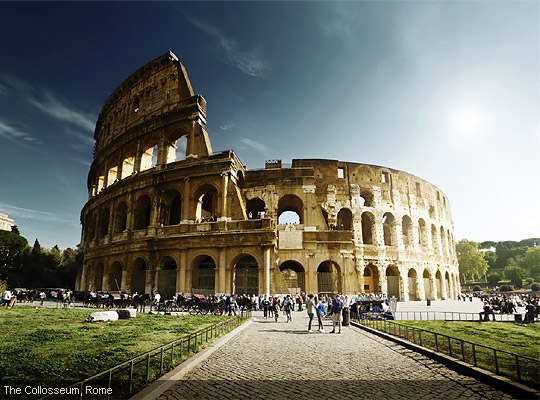Weather/ when to go:
Rome has a Mediterranean climate with hot, humid and dry summers and milder winters. November and December tend to see the most rain so you'll need to pack an umbrella if you're planning a winter visit. There is a small chance of snow during the winter, although this is quite rare. Spring and early autumn are popular times to visit the city as the weather is pleasant but not overly warm.Do & see:
The Collosseum
This amphitheatre is one of the most famous landmarks in Rome but it has a dark history. It dates from AD 80 and was commonly used to stage gladiator fights in which men would fight -- sometimes with animals -- for public entertainment and was also the scene of public exections. Not much of the original Collesseum is still standing after earthquakes, fire and plunder destroyed a lot of it but what remains is undoubtedly spectacular. Guided tours are available on most days but it's best to pre-book these to avoid disappointment.Address: Piazza del Colosseo
Website: www.pierreci.it
The Pantheon
Emperor Hadrian rebuilt the building to replace the Pantheon of 27 BC, which was destroyed by fire in 80 AD. Originally built as a temple to the Roman gods, the Pantheon is an impressive example of Roman architecture and is the best preserved building from ancient Rome. Buried here is the Renaissance painter, Raphael, and the Italian Kings, Vittorio Emanuele II and Umberto I.Address: Piazza della Rotonda
Trevi Fountain
This prominent tourist attraction is situated at the end of the Aqua Virgo, a aqueduct which has supplying fresh water to the city since 19 BC. The spectacular design features the sea god, Neptune. Legend has it that you will return to Rome if you throw a coin over your shoulder while facing away from the fountain. It gets its name from its location, which intersects three roads.Address: Piazza di Trevi
St Peter's Basilica
Located in the heart of the Vatican city, this is the largest Christian basilica in the world. In front of the Basilica is St Peter's Square, which features an Egyptian obelisk which was brought to Rome in 37 BC. In the grottoes beneath the Basilica, many popes and some royals are buried including Pope John Paul II. Inside the Basilica are various pieces of art including mosaics. Be aware that there is a dress code enforced for visitors which means that legs and shoulders in particular must be covered up. There are 320 steps to the top of the dome.Address: Piazza San Pietro
Website: www.vatican.va
The Vatican Museum and Sistine Chapel
If you're planning a trip to the Basilica, why not take a tour of the Vatican Museum while you're in the area? You can get around the museum without being part of a tour but as it's fairly extensive, many people prefer to take this option to make sure that they see all of the important attractions. There are several mini-museums within the main Vatican Museum so be sure to check whether the tour company that you choose will show you around as much of the galleries as possible. Most tours will also take in the Sistine Chapel but if you're not intending to make a separate visit to St Paul's Basilica, some will also take you around the inside of that too. As with the Basilica, you must be dressed appropriately and respectfully to be granted access.Address: Viale Vaticano
Website: www.vatican.va
The Roman Forum
This was the area around which Ancient Rome developed and was home to some of the most prestigious buildings including the Arch of Septimius Severus and the platforms for public speeches. Attractions include the Arco di Tito, the Temple of Saturn, the Temple of Vesta and the Church of San Luca e Martina.Address: Largo della Salara Vecchia
Website: www.pierreci.it
Palantine Hill
Walking up from the Roman Forum will take you to Palantine Hill. In Roman mythology, this hill is said to be the place at which Rome was first built. Over time, it became a popular place to live thanks to the views and the belief that the air was cleaner and healthier than down below. Marc Anthony lived here, as did many emperors who built their imperial palaces on the hill. Visit the Palatine Antiquarium Museum (which contains relics that have been found on the hill), see the many ruins and enjoy spectacular views of the city from your vantage point.Address: Via di San Gregorio 30
Website: www.pierreci.it
Museo Nazionale Romano
The National Museum of Rome is made up of four sites in the city: Palazzo Massimo; Terme di Diocleziano; Palazzo Altemps, and Crypta Balbi. It's one of the less commonly visited museums in the city so you can usually avoid the long queues associated with other museums. There is a free guided tour on Sundays (on a first come, first served basis until all spaces are full) but if you'd rather explore at your own leisure, one ticket will allow you to visit all four sites over three days.Address: Largo di Villa Peretti 1
Website: www.pierreci.it
Museo e Galleria Borghese
Art lovers will love a trip to this gallery, which contains original sculptures and paintings from the collection of Cardinal Scipione.Address: Piazzale del Museo Borghese
Website: www.galleriaborghese.it
Piazza del Popolo
Old meets new in this square, which is surrounded by churches and monuments and is located near the Borghese park. The impressive Porta del Popolo takes you though to the Via Flamina, which was once one of the most important roads into Rome. Also in the square are a large Egyptian obelisk and the Santa Maria dei Miracoli and Santa Maria in Montesanto churches. The churches are either side of the Via del Corso, which leads to the Piazza Navona.Address: Tridente nr Piazza Del Popolo



